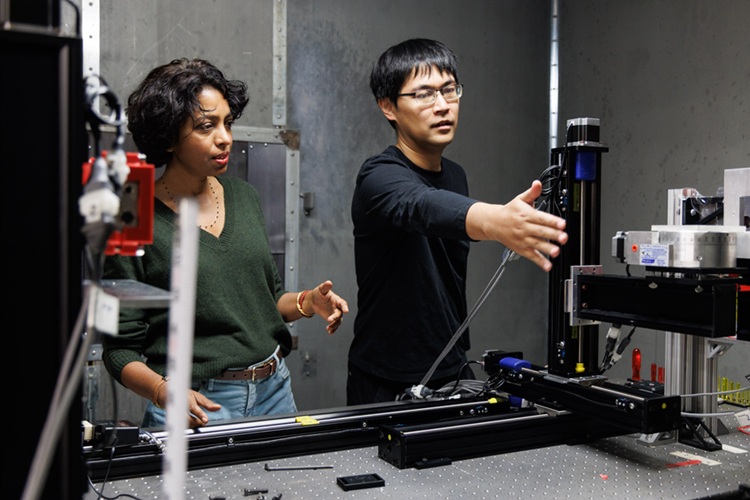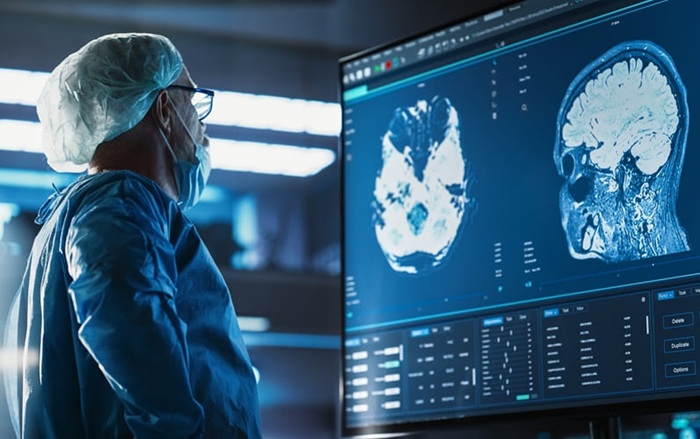Fujifilm Showcases New DR Detectors and AI Initiative in Chicago
|
By Theresa Herman, Regional Director Posted on 26 Nov 2018 |

Image: Fujifilm unveiled two new DR detectors at the RSNA annual meeting in Chicago (Photo courtesy of Fujifilm Medical Systems).
Fujifilm Medical Systems U.S.A, Inc, (Stamford, CT, USA), a provider of diagnostic imaging and medical informatics solutions, unveiled two new digital radiography (DR) detectors – the CALNEO Dual (available only in Japan) and the FDR ES – at the 2018 Radiological Society of North America (RSNA) annual meeting, November 25-30 in Chicago, Ill., USA. The company also presented, REiLI, its global Medical Imaging and Informatics Artificial Intelligence (AI) technology initiative, as well as hosted an educational symposium focusing on the impact of AI on enterprise imaging now and into the future.
The CALNEO Dual is a 17-inch x 17-inch standard cassette sized detector featuring two sensitivity capture layers, coupled with Fujifilm intelligent energy subtraction processing. A single exposure produces three images; traditional, soft tissue only and bone only views. These distinctly different images can be utilized for visualizing or tracking of lung cancer nodules. The innovative dual capture layer design yields higher definition general X-ray images, enhancing separation accuracy of bone detail and soft tissue.
Fujifilm’s new FDR ES detector is a next-generation X-ray room retrofit solution designed with the essential conveniences of Fujifilm DR image acquisition innovations. The light, portable detectors are packed with all the benefits of Fujifilm's high sensitivity detector technologies and the latest refinements in image processing. Optimized for existing X-ray room equipment, these detectors feature simplified integration for a more affordable DR retrofit without sacrificing dose, workflow and image quality performance. In addition to these latest and most advanced detectors, Fujifilm also showcased its comprehensive line of DR detectors and mobile DR solutions to suit the needs of large as well as small imaging facilities. At RSNA 2018, the company offered a glimpse into the future of DR detector technologies with an under the cover, inside view prototype display.
"Once again, Fujifilm is pushing the limits, expanding the capabilities of digital radiography," said Johann Fernando, Ph.D., CEO of FUJIFILM Medical Systems U.S.A, Inc. "Our latest advances with the CALNEO Dual represent a transformation in image capture technologies that will allow clinicians to visualize more detail than before and from a single exposure."
At RSNA 2018, Fujifilm also featured dedicated workstations demonstrating AI platform use cases within Synapse 5 PACS driven by REiLI. Under the REiLI brand, Fujifilm is developing AI technologies that strongly support diagnostic imaging workflow, leveraging the combination of deep learning in its AI technology with the company’s image processing heritage.
Applications currently in development include Region Recognition, an AI technology to accurately recognize and consistently extract organ regions, regardless of deviations in shape, presence or absence of disease, and imaging conditions; Computer Aided Detection, an AI technology to reduce the time of image interpretation and support radiologists’ clinical decision making; Workflow Support, using AI technology to realize optimal study prioritization, alert communications of AI findings, and report population automation.
“Our goal is to provide an open platform which manages the workflow and delivery of AI technologies through Synapse clinical applications enabled for AI results and use cases, and realize a new and more powerful diagnostic workflow that advances the field of radiology,” said Bill Lacy, Vice President of Medical Informatics at FUJIFILM Medical Systems, U.S.A, Inc.
The CALNEO Dual is a 17-inch x 17-inch standard cassette sized detector featuring two sensitivity capture layers, coupled with Fujifilm intelligent energy subtraction processing. A single exposure produces three images; traditional, soft tissue only and bone only views. These distinctly different images can be utilized for visualizing or tracking of lung cancer nodules. The innovative dual capture layer design yields higher definition general X-ray images, enhancing separation accuracy of bone detail and soft tissue.
Fujifilm’s new FDR ES detector is a next-generation X-ray room retrofit solution designed with the essential conveniences of Fujifilm DR image acquisition innovations. The light, portable detectors are packed with all the benefits of Fujifilm's high sensitivity detector technologies and the latest refinements in image processing. Optimized for existing X-ray room equipment, these detectors feature simplified integration for a more affordable DR retrofit without sacrificing dose, workflow and image quality performance. In addition to these latest and most advanced detectors, Fujifilm also showcased its comprehensive line of DR detectors and mobile DR solutions to suit the needs of large as well as small imaging facilities. At RSNA 2018, the company offered a glimpse into the future of DR detector technologies with an under the cover, inside view prototype display.
"Once again, Fujifilm is pushing the limits, expanding the capabilities of digital radiography," said Johann Fernando, Ph.D., CEO of FUJIFILM Medical Systems U.S.A, Inc. "Our latest advances with the CALNEO Dual represent a transformation in image capture technologies that will allow clinicians to visualize more detail than before and from a single exposure."
At RSNA 2018, Fujifilm also featured dedicated workstations demonstrating AI platform use cases within Synapse 5 PACS driven by REiLI. Under the REiLI brand, Fujifilm is developing AI technologies that strongly support diagnostic imaging workflow, leveraging the combination of deep learning in its AI technology with the company’s image processing heritage.
Applications currently in development include Region Recognition, an AI technology to accurately recognize and consistently extract organ regions, regardless of deviations in shape, presence or absence of disease, and imaging conditions; Computer Aided Detection, an AI technology to reduce the time of image interpretation and support radiologists’ clinical decision making; Workflow Support, using AI technology to realize optimal study prioritization, alert communications of AI findings, and report population automation.
“Our goal is to provide an open platform which manages the workflow and delivery of AI technologies through Synapse clinical applications enabled for AI results and use cases, and realize a new and more powerful diagnostic workflow that advances the field of radiology,” said Bill Lacy, Vice President of Medical Informatics at FUJIFILM Medical Systems, U.S.A, Inc.
Latest RSNA 2018 News
- New AI-Powered Lung Imaging Solution Launched at RSNA 2018
- Agfa Brings Intelligent Radiography to RSNA 2018
- Carestream Displays Several IT Offerings at Radiology Congress
- Double Black Imaging Announces Expanded Clinical LCD Line at Trade Show
- Lunit Unveils AI-Based Mammography Solution at RSNA 2018
- Guerbet Showcases Ongoing Collaboration with IBM Watson at Radiology Trade Fair
- M*Modal Launches Cloud-Based Version of AI-Powered Reporting Solution
- MDW Unveils First Radiology Blockchain Platform at RSNA 2018
- Teledyne DALSA Displays Xineos Family of CMOS X-ray Detectors
- SuperSonic Imagine Showcases New Ultrasound System at RSNA 2018
- CIVCO Medical Solutions Introduces Next-Generation of Ultrasound Accessories
- Subtle Medical Showcases Al for PET and MRI Scans at RSNA 2018
- Philips Launches New Platform to Enable Development of AI Assets
Channels
Radiography
view channel
X-Ray Breakthrough Captures Three Image-Contrast Types in Single Shot
Detecting early-stage cancer or subtle changes deep inside tissues has long challenged conventional X-ray systems, which rely only on how structures absorb radiation. This limitation keeps many microstructural... Read more
AI Generates Future Knee X-Rays to Predict Osteoarthritis Progression Risk
Osteoarthritis, a degenerative joint disease affecting over 500 million people worldwide, is the leading cause of disability among older adults. Current diagnostic tools allow doctors to assess damage... Read moreMRI
view channel
Novel Imaging Approach to Improve Treatment for Spinal Cord Injuries
Vascular dysfunction in the spinal cord contributes to multiple neurological conditions, including traumatic injuries and degenerative cervical myelopathy, where reduced blood flow can lead to progressive... Read more
AI-Assisted Model Enhances MRI Heart Scans
A cardiac MRI can reveal critical information about the heart’s function and any abnormalities, but traditional scans take 30 to 90 minutes and often suffer from poor image quality due to patient movement.... Read more
AI Model Outperforms Doctors at Identifying Patients Most At-Risk of Cardiac Arrest
Hypertrophic cardiomyopathy is one of the most common inherited heart conditions and a leading cause of sudden cardiac death in young individuals and athletes. While many patients live normal lives, some... Read moreUltrasound
view channel
Wearable Ultrasound Imaging System to Enable Real-Time Disease Monitoring
Chronic conditions such as hypertension and heart failure require close monitoring, yet today’s ultrasound imaging is largely confined to hospitals and short, episodic scans. This reactive model limits... Read more
Ultrasound Technique Visualizes Deep Blood Vessels in 3D Without Contrast Agents
Producing clear 3D images of deep blood vessels has long been difficult without relying on contrast agents, CT scans, or MRI. Standard ultrasound typically provides only 2D cross-sections, limiting clinicians’... Read moreNuclear Medicine
view channel
PET Imaging of Inflammation Predicts Recovery and Guides Therapy After Heart Attack
Acute myocardial infarction can trigger lasting heart damage, yet clinicians still lack reliable tools to identify which patients will regain function and which may develop heart failure.... Read more
Radiotheranostic Approach Detects, Kills and Reprograms Aggressive Cancers
Aggressive cancers such as osteosarcoma and glioblastoma often resist standard therapies, thrive in hostile tumor environments, and recur despite surgery, radiation, or chemotherapy. These tumors also... Read more
New Imaging Solution Improves Survival for Patients with Recurring Prostate Cancer
Detecting recurrent prostate cancer remains one of the most difficult challenges in oncology, as standard imaging methods such as bone scans and CT scans often fail to accurately locate small or early-stage tumors.... Read moreGeneral/Advanced Imaging
view channel
New Algorithm Dramatically Speeds Up Stroke Detection Scans
When patients arrive at emergency rooms with stroke symptoms, clinicians must rapidly determine whether the cause is a blood clot or a brain bleed, as treatment decisions depend on this distinction.... Read more
3D Scanning Approach Enables Ultra-Precise Brain Surgery
Precise navigation is critical in neurosurgery, yet even small alignment errors can affect outcomes when operating deep within the brain. A new 3D surface-scanning approach now provides a radiation-free... Read moreImaging IT
view channel
New Google Cloud Medical Imaging Suite Makes Imaging Healthcare Data More Accessible
Medical imaging is a critical tool used to diagnose patients, and there are billions of medical images scanned globally each year. Imaging data accounts for about 90% of all healthcare data1 and, until... Read more
Global AI in Medical Diagnostics Market to Be Driven by Demand for Image Recognition in Radiology
The global artificial intelligence (AI) in medical diagnostics market is expanding with early disease detection being one of its key applications and image recognition becoming a compelling consumer proposition... Read moreIndustry News
view channel
GE HealthCare and NVIDIA Collaboration to Reimagine Diagnostic Imaging
GE HealthCare (Chicago, IL, USA) has entered into a collaboration with NVIDIA (Santa Clara, CA, USA), expanding the existing relationship between the two companies to focus on pioneering innovation in... Read more
Patient-Specific 3D-Printed Phantoms Transform CT Imaging
New research has highlighted how anatomically precise, patient-specific 3D-printed phantoms are proving to be scalable, cost-effective, and efficient tools in the development of new CT scan algorithms... Read more
Siemens and Sectra Collaborate on Enhancing Radiology Workflows
Siemens Healthineers (Forchheim, Germany) and Sectra (Linköping, Sweden) have entered into a collaboration aimed at enhancing radiologists' diagnostic capabilities and, in turn, improving patient care... Read more






















